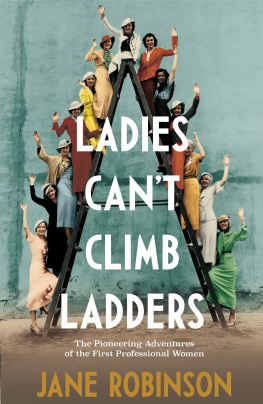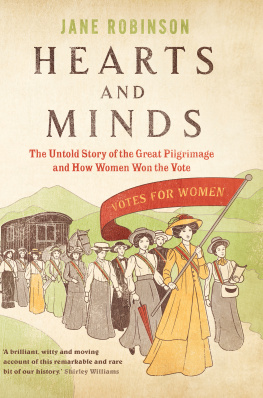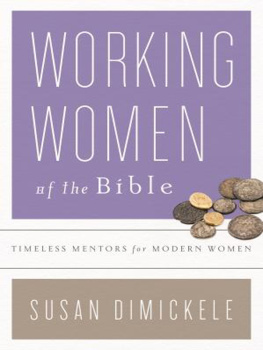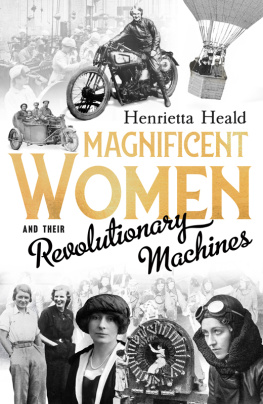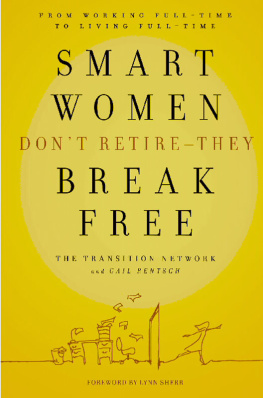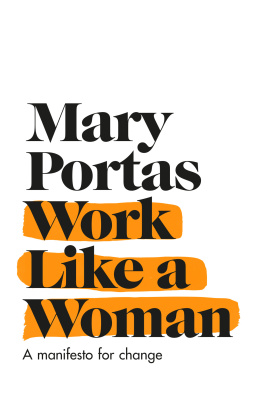Also by Jane Robinson
Wayward Women
Unsuitable for Ladies
Angels of Albion
Parrot Pie for Breakfast
Pandoras Daughters
Mary Seacole
Bluestockings
A Force to be Reckoned With
In the Family Way
Hearts and Minds
For more information on Jane Robinson and her books, see her website at www.jane-robinson.com
Jane Robinson
LADIES CANT CLIMB LADDERS
The Pioneering Adventures of the First Professional Women

TRANSWORLD PUBLISHERS
6163 Uxbridge Road, London W5 5SA
penguin.co.uk
Transworld is part of the Penguin Random House group of companies whose addresses can be found at global.penguinrandomhouse.com.

First published in Great Britain in 2020 by Doubleday
an imprint of Transworld Publishers
Copyright Jane Robinson 2020
Cover design by Jo Thomson/TW
Cover image Shutterstock
Jane Robinson has asserted her right under the Copyright, Designs and Patents Act 1988 to be identified as the author of this work.
Every effort has been made to obtain the necessary permissions with reference to copyright material, both illustrative and quoted. We apologize for any omissions in this respect and will be pleased to make the appropriate acknowledgements in any future edition.
A CIP catalogue record for this book is available from the British Library.
ISBN 9781473559608
This ebook is copyright material and must not be copied, reproduced, transferred, distributed, leased, licensed or publicly performed or used in any way except as specifically permitted in writing by the publishers, as allowed under the terms and conditions under which it was purchased or as strictly permitted by applicable copyright law. Any unauthorized distribution or use of this text may be a direct infringement of the authors and publishers rights and those responsible may be liable in law accordingly.
For Dr Tammy Oxley
Introduction
Never let anybody guess that you have a mind of your own.
T HIS IS THE STORY OF some of the twentieth centurys most influential women, whose entry into the lite fields of medicine, law, the Church, architecture, engineering and academia shaped the personal and professional lives of working women today. A few of them are famous; most are barely remembered beyond their own families. Yet all of them were pioneers, adventurers in a forbidden land thicketed with centuries of prejudice and hidden danger. Not the sort of danger likely to cost lives (although that did happen), but the sort that put their roles and reputations on the line, threatened their moral integrity, their very identity as female members of society.
The history of progress is full of transgressors, and thats exactly what these women were. To sense just how alien they must have felt in the professional workplace of their time, at the beginning of my research for this book I took myself on a tour of London. I wanted to see what they saw; to imagine how daunting it must have been to attempt an invasion of the Establishments strongholds a century ago. I was confident that little enough would have changed in the buildings fabric, at least for this experiment to work.
I started out on Westminster Bridge, close to where I planned to set the beginning of the book. On the south bank of the Thames, beyond the modern tower block of St Thomas Hospital, I could see the long faade of the nineteenth-century building, for ever associated with Florence Nightingale. I had just seen her likeness in bronze in St Jamess, the heart of gentlemens clubland, on my way from Piccadilly Circus. She was still is the caring profession personified.
Opposite the hospital stands the Palace of Westminster. Only one female MP sat in the House of Commons in 1920, but she cant have been lonely: in the Queens Robing Room, for instance, William Dyces frescoes of chivalric virtues are adorned with scores of women. In the tableau called Mercy, Sir Gawain swears (as Dyce puts it) never to be against ladies. Ironic, given the vehemence of opposition to womens suffrage among MPs at the time, but comforting none the less.
I walked up Whitehall and turned into King Charles Street to gaze at the old seat of Empire, the Foreign and Commonwealth Office. Ordinary members of the public can visit it only on special open days, but several years ago a diplomat friend took me inside. Again, I remember swarms of women. Not real ones, of course, but extravagant figures representing entire continents, and a goddess-like Britannia surveying her subjects with a stern, blank stare.
It was time to move on. At Trafalgar Square I turned right to Charing Cross (named for Edward Is monument to his Queen Eleanor) and made towards the City of London. I passed the Central Criminal Court at the Old Bailey on the way, and saw the famous gilded figure perfectly balanced on the dome, wielding a sword in her right hand and the scales of justice in her left: the epitome of wisdom. Eventually I reached the heart of the financial district, presided over by the Old Lady of Threadneedle Street, the Bank of England.
Once I got my eye in, I realized that all over the place buildings were festooned with bas-reliefs invoking women. There were statues of queens; of the Blessed Virgin Mary; of saints and patronesses. I walked by the river to photograph a visiting tall ship (she was beautiful) before crossing to Waterloo, where I was welcomed at the stations vast, arched entrance by yet another stony-faced Britannia. Its a pity I couldnt have gone home in a steam train, to complete my perversely feminine journey: they are invariably described as ladies too.
Im glad I made that tour. I had not realized before how potent the image of idealized womanhood was in public life, and how ubiquitous. Her dominant presence in the Establishment of the nineteenth and early twentieth centuries made it even more difficult for flesh-and-blood women half the human race to gain access. A real Victorian ladys place was nowhere near the inner sanctum of the traditional professions. She was the Angel in the House, characterized by Coventry Patmore in his endless poem of the same name as utterly innocent, utterly selfless, utterly beautiful and so graceful that she somehow seemed to float an inch or two above the ground.
The Angels natural habitat was the drawing-room or the nursery. Her duty was to marry as well as possible and to make others happy. If she must work as an unfortunately distressed gentlewoman, perhaps, or a chronic spinster then let her teach or, at a push, train for nursing; but always with an ambition to stop as soon as she could. (These are ladies were talking about; women, on the other hand, were expected to labour in factories, domestic service, anywhere that would have them. Men had careers; women had jobs; ladies, like children, behaved nicely and did what they were told.)
The first faint cracks in this divinely ordained order appeared during the late 1860s, when women were admitted to a growing number of British universities, though not always awarded degrees at the end of their studies. The campaign for womens suffrage gathered momentum at around the same time, and with it the concept of womens rights. As access to higher education widened and collective confidence grew through political activism, women began to demand, politely or otherwise, to be allowed a meaningful role in public life.
The First World War gave them just that, but only temporarily. Afterwards, the Establishment expected them to strap on their angel wings again, go home and subside into domesticity. True, the vote was won in 1918, but only partially. The Sex Disqualification (Removal) Act was passed in December 1919, but its scope was limited and easily misconstrued. And the habits of the past were hard to break. Virginia Woolf, embarking on her career as a professional writer, may have refused to play the part of the Angel but was only too well aware of her influence:

